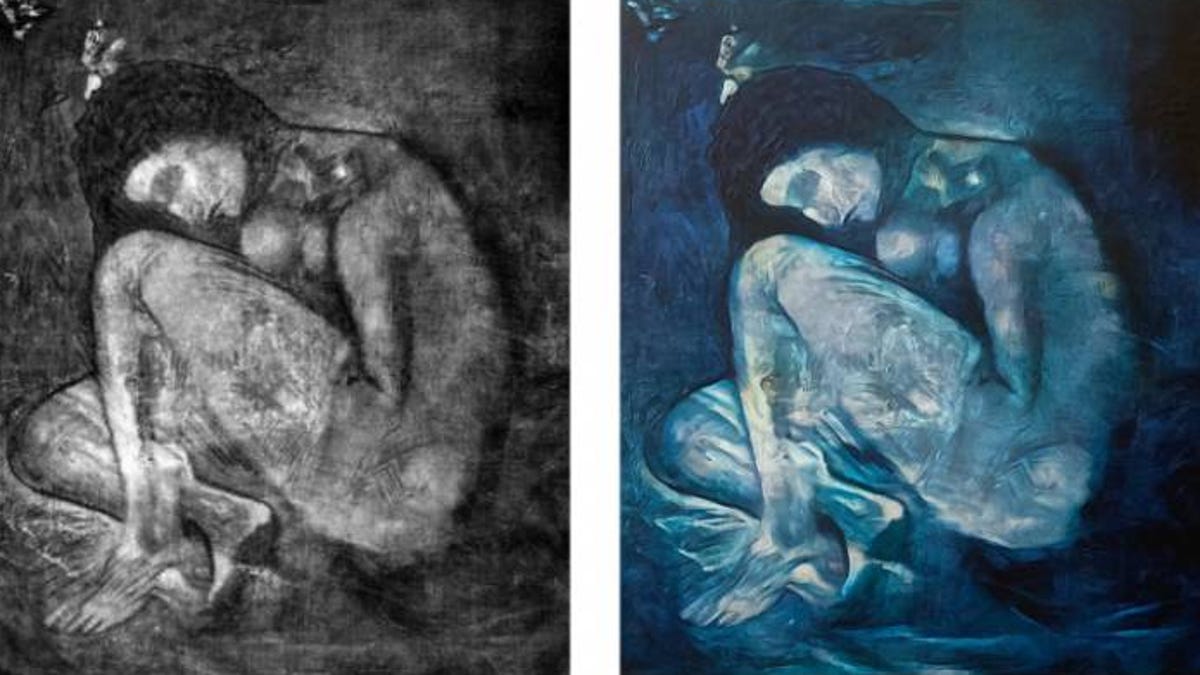AI paints a Picasso nude, just like Pablo did
"Lost" Picasso nude comes out of hiding, thanks to artificial intelligence and 3D printing.

Left, an X-ray showing Lonesome Crouching Nude, a work found beneath Picasso's The Blind Man's Meal. On the right, a full-color re-creation.
Before he became famous, Pablo Picasso didn't always have money for art materials, so, like other struggling artists, he'd paint over existing canvases to create new works, thus concealing the earlier images.
One such painting, cloaked under another for more than a century, has gotten new life, thanks to AI.
It's a painting of a nude woman, dubbed The Lonesome Crouching Nude. In 2010, X-rays revealed it hidden beneath Picasso's 1903 oil painting The Blind Man's Meal, considered one of the most important works from the artist's expressionist Blue Period from 1901 to 1904. During that time, he painted somber, largely monochromatic works in blue and blue-green hues, with occasional highlights of warm tones like rust or gold.
Picasso rendered the crouching nude woman in characteristic Blue Period tones, at least according to a re-creation that replicates the painting down to 3D brushstrokes. It's on display through Sunday at the inaugural Deeep AI art fair from the London-based Morf Gallery, which describes itself as a futuristic online gallery showcasing limited-edition fine art.
Researchers from University College London re-created the painting using an original algorithm that studied dozens of Picasso's paintings and trained itself in the Spanish artist's style. Using the X-rayed image as a guide, it applied its understanding of Picasso to the full-size, full-color replica.
"It's quite eerie seeing the brushstrokes, the color and the way in which lights reflects off the work," said George Cann, one of two UCL Ph.D. researchers who brought the 20th century piece back to life with modern tools. "It's a beautiful piece."
It was also likely significant to the artist. The crouching woman appears as one of two unfinished painting in the background of another famous Picasso Blue Period piece, La Vie (The Life).
"The fact that the woman within The Lonesome Crouching Nude is also within La Vie and a few of Picasso's sketches suggests that Picasso may have had an affinity towards this woman," Cann said in a statement.
Cann and fellow UCL doctoral candidate Anthony Bourached have created a system for reproducing art that's been painted over. The tools include X-ray and/or infrared imagery to reveal the hidden work; a neural network that can reproduce the work after studying the artist's cache; a heightmap for elevation modeling; and a 3D printer for printing a textured piece. Cann and Bourached call their art reconstruction initiative Oxia Palus, and they've applied it to another hidden Picasso, La Femme Perdue, as well as a lost Modigliani.
"I believe Picasso actively welcomed such forensics," Bourached said, "since he himself said, 'I just painted the images that rose before my eyes. It is for other people to find the hidden meanings.'"
The Lonesome Crouching Nude isn't the first hidden painting from Picasso's Blue Period to be revealed. In 2014, infrared imaging unveiled a portrait of a bearded man underneath another Blue Period work, The Blue Room, which depicts a woman bathing.

